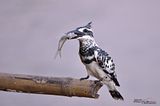August 1 was my last day with the 5D Mark II, so I hurried to Asami area to photograph a pair of Red-rumped Swallows (Cecropis daurica japonica) which was nesting in a building on the roadside. Furuso-san told me about this nest while we met at Shiraki few days earlier. She told me that the nest was very close and showed me some photos of the adult birds at close range taken by her digital compact camera. The birds still seemed to be building the nest when she took those photos, so they could still be seen even when they perched at the nest. As I arrived there in the morning of August 1, I could only see the head of a parent bird popping up from the already finished nest. I knew right then that it was not going to be easy anymore, and it really wasn't.



The bird's nest was located above the second floor's balcony. I really wished I could go up to the second floor and photograph the birds at eye level, but I just couldn't enter the building, so I had to take their photos from below. The birds seemed to be incubating the eggs and hardly showed up at the entrance of the nest. Parent birds switched their turns to incubate every 20 minutes or so. It was so difficult to take photos of them because even when they came back to the nest, they never stopped in front of the nest, but went right through into it. I almost gave up, but then around noon, one of the parent birds came perching on the wire in front of the nest to preen and sing. It constantly flew out and came back in 20 or 30 minutes. That's the only time when I could get some decent photos of it.





Parent bird singing and preening



I've always believed that Red-rumped Swallow has complete rufous nucal collar, different from its South-East Asian counterpart Striated Swallow (Cecropis striolata). Apart from being a bit larger and having bolder streaks on underparts, I've always thought that Striated Swallows can be distinguished from Red-rumpeds by its dark bluish nape. However, I was convinced that Red-rumped Swallows also don't necessarily have nuchal collar. Even when the bird turned its hind neck to me, I still couldn't see the rufous nuchal collar that many field guides illustrate. Now I begin to realise how difficult it actually is to distinguish the two species. Here's a nice photo of a Striated Swallow from Indonesia for comparison.




















































.jpg)
